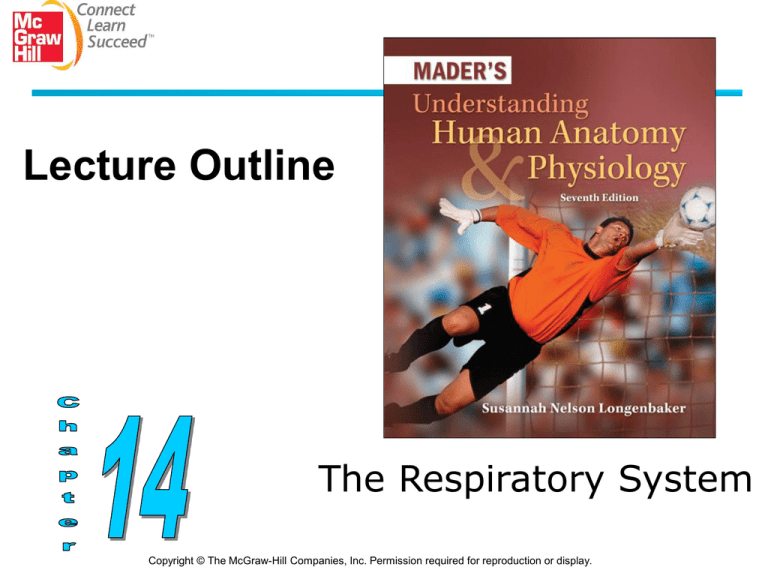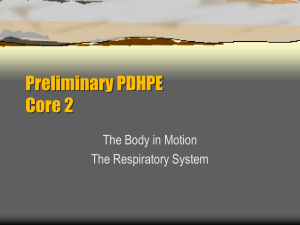1 - Lone Star College
advertisement

Lecture Outline The Respiratory System Copyright © The McGraw-Hill Companies, Inc. Permission required for reproduction or display. The Respiratory System o o Major function is gas exchange Works with the cardiovascular system to accomplish: • • • • Breathing External respiration Internal respiration Transport of gases The Respiratory System o The Respiratory Tract • Nasal hairs, cilia, and mucus cleanse inhaled air • • Lysozyme in the mucus help kill bacteria Mucociliary escalator Inhaled air is warmed by superficial blood vessels lining the airways Air is moistened by the mucous membrane The Respiratory System • The Nose The only external portion of the respiratory system Contains two nasal cavities Lined by a mucous membrane Nasal conchae increase the surface area for moistening and warming inhaled air Odor receptors located in the olfactory epithelium The Respiratory System • The Pharynx (the “throat”) Connects the nasal and oral cavities to the larynx Three parts: Nasopharynx Oropharynx Laryngopharynx Tonsils provide the primary lymphatic tissue defense for breathing The air passage and the food passage cross The Respiratory System • The Larynx Passageway for air between the pharynx and trachea Houses the vocal cords The epiglottis prevents food from entering the larynx The Respiratory System • The Trachea (the windpipe) Connect the larynx to the primary bronchi Ventral to esophagus C-shaped cartilaginous rings Mucosal lining has pseudostratified ciliated columnar epithelium that form the mucociliary escalator The Respiratory System • The Bronchial Tree The trachea divides into the right and left primary bronchi The primary bronchi branch into secondary bronchi Three for the right lung Two for the left lung The secondary bronchi divide into tertiary bronchi Bronchioles are the smallest conducting airways The Respiratory System o The Lungs • • • Paired, cone-shaped organs Each lobe is divided into lobules Each lobule has a bronchiole that serves many alveoli Pleurae • Double layered serous membrane The visceral pleura adheres to the surface of the lung The parietal pleura lines the inside of the thoracic cavity Produces a lubricating serous fluid The Respiratory System • The Alveoli Alveolar sacs are made up of simple squamous epithelium surrounded by blood capillaries Site of gas exchange Alveoli must stay open to receive inhaled air Surfactant lowers the surface tension of water lining the alveoli preventing them from collapsing completely Respiratory distress syndrome occurs in premature infants who lack surfactant The Respiratory System • Respiratory Membrane Facilitates rapid gas exchange Composed of juxtaposed alveolar epithelium and the capillary epithelium Extremely thin Large surface area (50-70m2) Mechanism of Breathing o Ventilation • The manner in which air enters and exits the lungs Conditions to consider: • The lungs lie within the sealed-off thoracic cavity The lungs adhere to the thoracic cavity wall by way of the pleurae A continuous column of air extends from the pharynx to the alveoli of the lungs Mechanism of Breathing • Inspiration Active phase of ventilation Diaphragm contracts and flattens External intercostal muscles contract, and the rib cage moves upward and outward Thoracic cavity volume increases, causing the lungs to increase in volume Air pressure within the alveoli (intrapulmonary pressure) decreases Air flows from an area of higher pressure (atmospheric pressure) to an area of lower pressure (within the lungs) Figure 14.6a Mechanism of Breathing • Expiration Usually the passive phase of ventilation The diaphragm relaxes and resumes its dome shape The intercostal muscles relax and the rib cage moves down and in The volume of the thoracic cavity decreases and the lungs recoil Lung volume decreases and the intrapulmonary pressure increases Since intrapulmonary pressure is now greater than atmospheric pressure, air will flow out of the lungs Mechanism of Breathing • Maximum Inspiratory Effort Involves the accessory muscles of respiration • Erector spinae Pectoralis minor Scalene and sternocleidomastoid muscles Help increase the size of the thoracic cavity larger than normal Forced Expiration During heavy exercise, singing, etc. Involves contraction of abdominal wall muscles Mechanism of Breathing o o Spirometer – instrument that records the volume of air exchanged during breathing Spirogram – shows the measurements recorded by a spirometer Mechanism of Breathing o • Respiratory Volumes Tidal volume Normal, relaxed breathing About 500 mL • Vital capacity Maximum volume of air that can be inhaled plus the maximum volume of air that can be exhaled Depends on: • Inspiratory reserve volume Forced inspiration Increases the volume of air beyond the tidal volume by 2,900 mL Expiratory reserve volume Increased volume of expired air 1,400 mL Residual volume Amount of air remaining in the lungs after a forced expiration 1,000 mL Mechanism of Breathing • Control of Ventilation Controlled by a primary respiratory center in the medulla oblongata The phrenic nerve carries impulses to the diaphragm The intercostal nerves stimulate the external intercostal muscles Normal breathing rhythm also requires input from the pons Mechanism of Breathing Can be influenced by nervous and chemical input Nervous input Can influence depth and rate of breathing Cerebral cortex, limbic system, hypothalamus, and other brain centers Chemical input The respiratory center is sensitive to the levels of CO2 and H+ Chemoreceptors in the carotid and aortic bodies are sensitive to the level of oxygen in the blood Gas Exchange and Transport o • External Respiration Exchange of gases in the lungs (between the air in the alveoli and the blood in the pulmonary capillaries) Oxygen • • Higher concentration in the alveoli Diffuses from the alveoli into the blood Carbon dioxide • Higher concentration in the blood Diffuses from the blood in the pulmonary capillaries to the alveoli Partial pressure Amount of pressure exerted by each gas Symbolized as PO2 and PCO2 Alveolar PO2 is higher than in the blood Gas Exchange and Transport o Internal Respiration • Exchange of gases in the tissues (between the blood in systemic capillaries and tissue fluids) Oxygen • • Carbon dioxide • Higher concentration in the blood Diffuses from the blood into the tissue fluid Higher concentration in the tissue fluid Diffuses from the tissue fluid into the blood PO2 in the tissue fluid is lower than in the blood Gas Exchange and Transport o Gas Transport • Oxygen Transport Transported by hemoglobin in the red blood cells • Can combine with oxygen – oxyhemoglobin Can release oxygen - deoxyhemoglobin Small amount transported in the plasma Carbon Dioxide Transport Gas Exchange and Transport • Carbon Dioxide Transport As a dissolved gas in blood plasma and in the cytoplasm of red blood cells Combined with globin portion of hemoglobin – carbaminohemoglobin Most is carried as bicarbonate ions Carbon dioxide combines with water to form carbonic acid Carbonic acid dissociates into hydrogen ions and bicarbonate ions Excess H+ combines with the globin portion of hemoglobin (reduced hemoglobin) Bicarbonate ions diffuse out of red blood cells into the plasma Gas Exchange and Transport • pH The respiratory system regulates pH Bicarbonate/Carbonic acid buffer system is altered by breathing. Hypoventilation = increased CO2 = decreased pH = acidosis (pH less than 7.35) Hyperventilation = decreased CO2 = increased pH = alkalosis (pH greater than 7.45) Respiration and Health o Upper Respiratory Tract Infections • Can spread from the nasal cavities to the sinuses, middle ears, and larynx Viral infections can lead to secondary bacterial infections Strep throat • • Primary bacterial infection Caused by streptococcus pyogenes Can lead to a generalized upper respiratory infection Respiration and Health • Sinusitis Infection of the cranial sinuses Develops when nasal congestion blocks openings to the sinuses Symptoms include: Postnasal discharge Facial pain Treatment depends on restoring proper drainage of the sinuses Respiration and Health • Otitis Media Bacterial infection of the middle ear Often a complication seen in children who have a nasal infection Pain is the primary symptom Other symptoms include: Sense of fullness Hearing loss Vertigo Fever Treatment is antibiotics Respiration and Health • Tonsillitis Tonsils become inflamed and enlarged Tonsillectomy – surgical removal of tonsils • Laryngitis Inflammation of the larynx Hoarseness leads to the inability to talk in an audible voice Causes: Upper respiratory infection Overuse Respiration and Health o Lower Respiratory Tract Disorders • Lower Respiratory Infections Bronchitis Bacterial infection of the primary and secondary bronchi Usually preceded by a viral URI Pneumonia Viral or bacterial infection of the lungs Bronchi and alveoli fill with thick fluid Risk factors include: Advanced age Weakened immune system Smoking and being immobilized May be localized in specific lobules of the lungs Respiration and Health Tuberculosis Caused by the tubercle bacillus bacterium Lung tissue develops tubercles around the invading pathogens Tuberculosis skin test can detect if a person has ever been exposed to the bacteria Respiration and Health • Restrictive Pulmonary Disorders Vital capacity is reduced Lungs have lost their elasticity Pulmonary fibrosis Fibrous connective tissue buildup in the lungs Can be caused by inhaling: Silica Coal dust Asbestos Clay Cement Flour Fiberglass Respiration and Health • Obstructive Pulmonary Disorders Air does not flow freely in the airways Maximal inhalation or exhalation time is greatly increased COPD Develop slowly, over a long period of time Recurrent Chronic bronchitis Airways are inflamed and filled with mucus Bronchi have undergone degenerative changes Respiration and Health Emphysema Incurable disorder Alveoli are distended Alveolar walls have been damaged and the surface area available for gas exchange has been reduced Often preceded by chronic bronchitis Lungs have lost their elasticity Exhaling is difficult and residual volume increases Less oxygen reaches the heart and brain Respiration and Health Asthma – acute obstructive disorder Disease of the bronchi and bronchioles Marked by: Wheezing Breathlessness Sometimes a cough and expectoration of mucus Airways are sensitive to irritants Is not curable, but treatable Respiration and Health Lung Cancer Linked to smoking Progressive steps in the development of lung cancer: Thickening and callusing of the cells lining the primary bronchi Cells with atypical nuclea appear in the callused lining Cells break loose and penetrate other tissues (metastasis) Pneumonectomy – surgical removal of a lobe of a lung or removal of the entire lung Effects of Aging o o o o o o Respiratory fitness decreases with age Maximum breathing capacities decline Gas exchange in the lungs becomes less efficient Respiratory membrane thickens Ciliated cells of the trachea decline in number Respiratory diseases are more common Homeostasis o o o o Gas Exchange Regulation of Blood pH Control of Blood Pressure Defense







